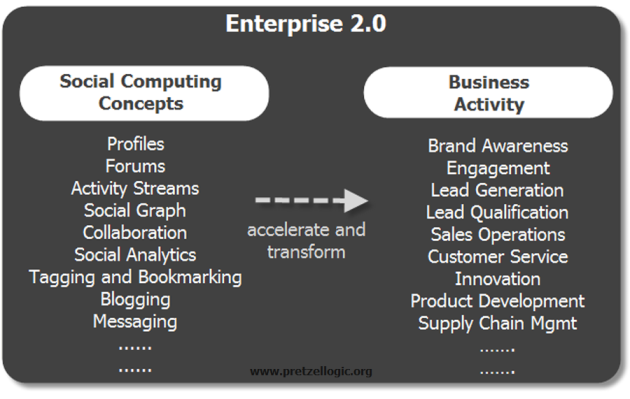Would You Manage CRM with a Wiki?
October 19, 2009 2 Comments
Or human resources with a blog? How about project management with forums?
Funny questions to ask, no doubt. Of course it’s not possible to effectively address many of the critical business functions using basic Enterprise 2.0 tools. Yet when it comes to social software, it often seems that the only game in town is to be a provider of such tools. For instance, Gartner’s Social Software Magic Quadrant requires that vendors have wikis, blogs and forums to be considered (side note – for the record, Spigit has all three social software tools and more).
I am fully on board that there are great opportunities for new types of communication, collaboration and information discovery in these tools. For instance, see my post, Microblogging Will Marginalize Corporate Email.
But there’s an enormous opportunity for applying the ethos and value of ‘social’, ‘transparency’ and ‘collaboration’ to a wider range of business processes. Key here is not to force specific processes into a general purpose tool, but to bring social software ethos to longstanding enterprise activities.
Hmm…sounds Dachis Group-like (“social business design”), eh?
Activity-Specific Social Applications
In the recent Gartner Social Software Hype Cycle, analyst Anthony Bradley introduced a new category, Activity-Specific Social Applications:
“As social software implementations mature, application patterns are evolving, and the software industry is responding with activity-centric social application offerings rather than with generic social software capability suites. Delivering a targeted social solution with a general purpose social tool (such as wikis and blogs) can involve significant development, configuration, and templating effort.”
Bradley has identified the next opportunity in enterprise social social software. Integrating the valuable characteristics of social software into the in-the-flow activities that make up our days. As a percentage of employees’ time, activity-specific social applications will be quite large.
Back in March 2009, Sameer Patel wrote, don’t confuse Enterprise 2.0 with social computing concepts. He was making this exact point, and included this illustrative diagram:
His point is that the left side are tools, whereas the right side are results-based activities. Key here is to create applications aligned with the processes for those activities. That means going deeper than a general purpose tool.
Successful Applications Will Be Designed for Results
So back to the original question. Would you manage CRM with a wiki? Could you? Perhaps there’s a geek hack to do this, but for mainstream business, the answer is ‘no’. Customer relationship management includes:
- Case management
- Customer revenue analytics
- Sales pipeline
- Individual prospect opportunity workflow
- And lots of other stuff
It would be really hard to use generic off-the-shelf social software to deliver the above functionality. Yet, going back in time, here’s what was prescribed for CRM success in April 2002:
People [who fail] don’t integrate CRM into the other parts of their business or implement CRM as a stand-alone and don’t have it communicate with core systems. A bigger and more frequent stumbling block is forgetting to address the people issues around a CRM implementation. In almost all of the cases we described earlier, CRM is a behavior modification tool.
There is a need for the “hard” functions that CRM can provide, like case management, campaigns and analytics. But that’s not enough (e.g. see social CRM), and enabling the customer-centric firm seems to require a good bit of what makes Enterprise 2.0 tick: cross-organizational perspectives, contributions from different departments, a more collaborative orientation to an end-goal. Integrate CRM into “other parts of their business”.
Wikis, by themselves, don’t provide the necessary CRM functions that are table stakes to be useful for companies. But CRM platforms could benefit from integrating more social software tools and conventions.
And that’s the case for a lot of the current processes that define companies today. They aren’t going to be addressed by off-the-shelf generic social software tools. But they benefit by incorporation of social software tools.
“Activity-specific social applications”. A few examples:
- Spigit: innovation management
- RollStream: trading partner social software
- Helpstream: customer service and social CRM
Dachis Group talks about social business design as “the intentional creation of dynamic and socially calibrated systems, process, and culture.” Indeed, there’s a huge opportunity to apply social software to the multitude of applications and processes that make up organizations, beyond the insertion of standalone generic tools.
Watch this space.

Pingback: Would You Manage CRM with a Wiki? | CloudAve
Hi Hutch! Sameer’s diagram says it all. At first I couldn’t understand what makes up an Enterprise 2.0. These Social Computing Concepts are now used to maximize their own purpose. From networking to other business activities. Thanks for sharing the diagram.